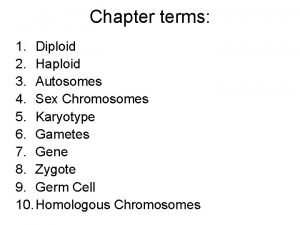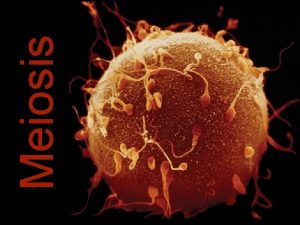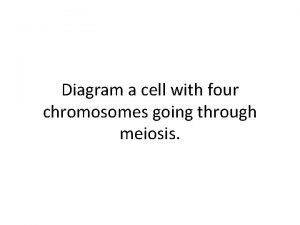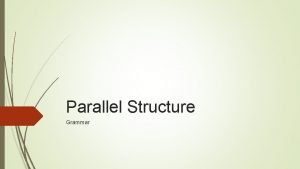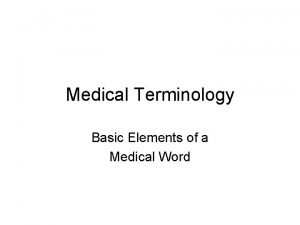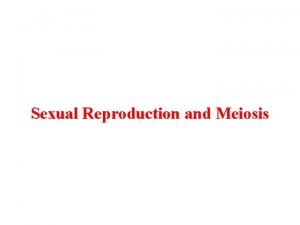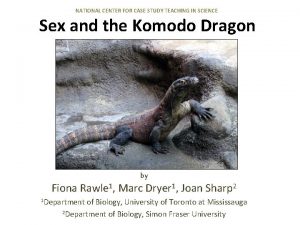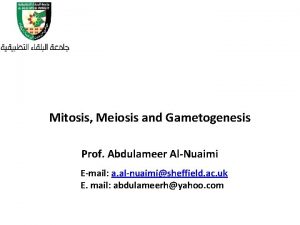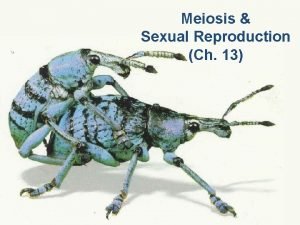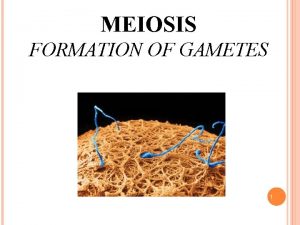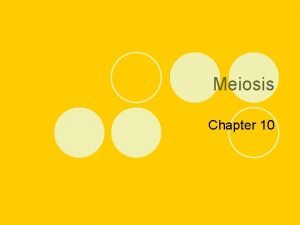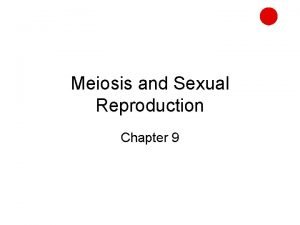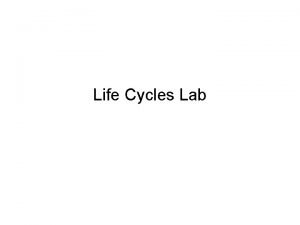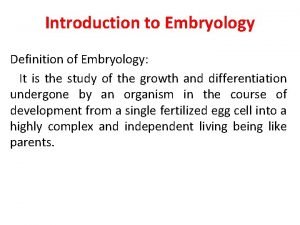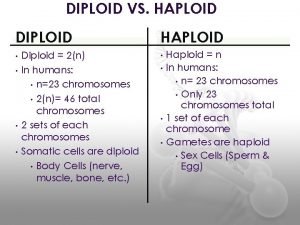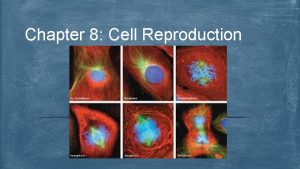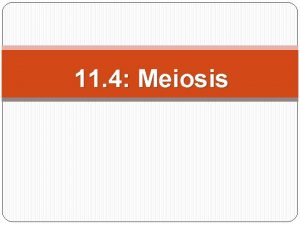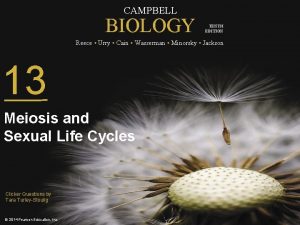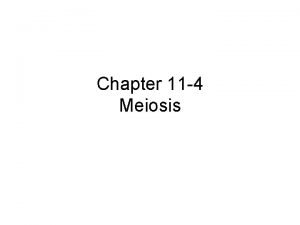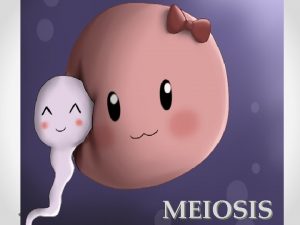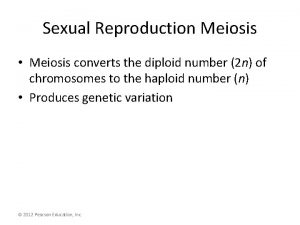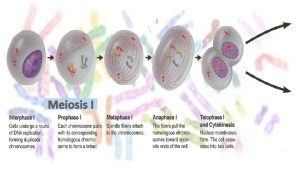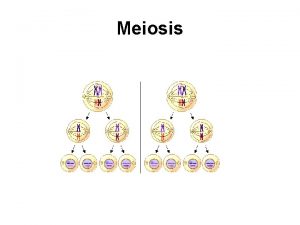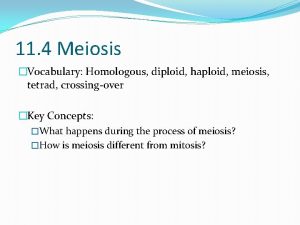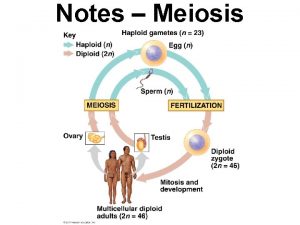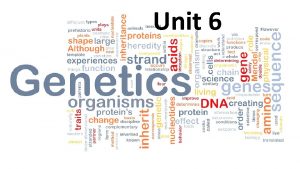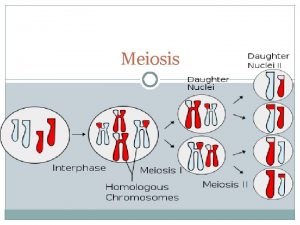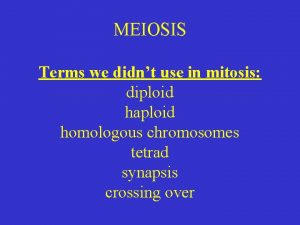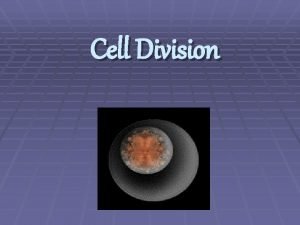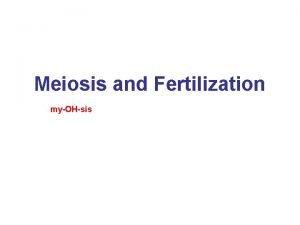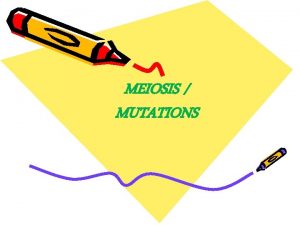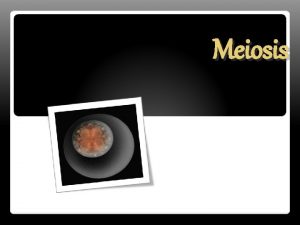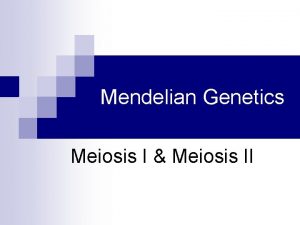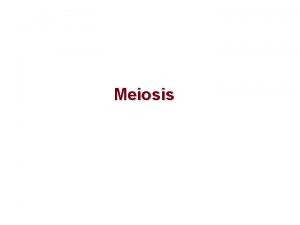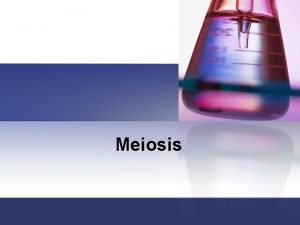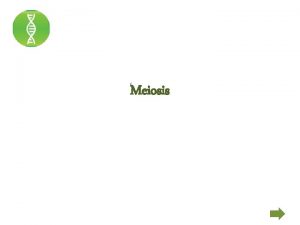Meiosis Important terms Diploid 2 n means having



































- Slides: 35

Meiosis

Important terms: • Diploid (2 n) means having paired chromosomes • Haploid (n) means single chromosomes (NOT paired) – In human somatic (body) cells there are 46 chromosomes (23 pairs) therefore we say this is diploid (2 n) – In human sperm or egg cells there are 23 chromosomes (half the number of chromosomes) therefore we say this is haploid (n)

• Gamete – a sex cell (ex: sperm or egg)

What is meiosis? • Meiosis is a process that makes gametes – In animals, this process makes sperm and eggs. – In plants, this process makes spores or seeds.

What are the phases of Meiosis? • Meiosis is similar to mitosis, but there is an extra set of phases for each stage. • Since there is an extra set of phases they are labeled Meiosis I and Meiosis II • As in mitosis, chromosomes replicate prior to cell division

What is a tetrad?

What are homologous chromosomes? • They contain genes for the same traits, but different versions of those genes (ex: blue eyes from mom & green eyes from dad) • One of each homologous pair came from the father (paternal) and one came from the mother (maternal)

What is the Synapses? • The pairing of homologous chromosomes

What is crossing over? • The exchange of genetic material between homologous chromosomes during synapsis http: //highered. mcgrawhill. com/sites/0072495855/student_view 0/cha pter 28/animation__random_orientation_of_c hromosomes_during_meiosis. html

What is reduction division? • Cell division that produces reproductive cells. The parent cell divides into four daughter cells each containing half the number of chromosomes

What makes Meiosis different from Mitosis? • Meiosis involves two separate cell divisions (Meiosis I and Meiosis II) • The resulting daughter cells have half the number of chromosomes as the parent cell. Therefore daughter cells are NOT identical to parent cell.

• In meiosis, a diploid cell (2 n) produces four haploid (n) daughter cells Meiosis I - reduces the number of chromosomes from diploid to haploid. This is referred to as reduction division. Meiosis II – is the same as mitosis


Phases of Meiosis • There are 8 phases (stages) of Meiosis

PROPHASE I • The nuclear membrane begins to disappear • Centrioles move to opposite poles and spindle fibers are made • Chromosomes come together in homologous pairs, this structure is called a tetrad because it consists of 4 chromatids • During this time crossing-over can occur

http: //highered. mcgrawhill. com/sites/0072495855/stud ent_view 0/chapter 28/animation __random_orientation_of_chro mosomes_during_meiosis. html

• Over view of Prophase I: Chromosomes form, homologous chromosomes start to pair up and crossing over can occur. This creates more genetic diversity.

METAPHASE I • Chromosomes line up in middle of cell, but they line up in HOMOLOGOUS PAIRS • Crossing-over can occur here too


ANAPHASE I • Chromosomes are pulled apart, but it is DIFFERENT than mitosis. • The centromeres DO NOT divide, instead chromosomes stay together. • One chromosome from each homologous pair is pulled to opposite ends of the cell.


TELOPHASE I • The cell contents divide. • The nuclear membrane may reappear, but cell usually goes into Prophase II.


What is the result of meiosis I? • At the end of Meiosis I, each of the two cells has HALF the original number of chromosomes • One chromosome from each original homologous pair. • Since the chromosome number is halved, Meiosis I is referred to as reduction division. The two haploid daughter cells are NOT identical

http: //www. phschool. com/science/biology_place/biocoach/meiosis/proii. html

MEIOSIS II • Meiosis II is exactly like mitosis. • Prophase II – Chromosomes appear and nuclear membrane breaks down (if present)

• Metaphase II – Chromosomes line up at centre of cell and attach to spindle fibers

Anaphase II – Centromeres divide. Replicated chromatids are pulled to opposite ends of the cell

• Telophase II – Cell contents divide. Chromosomes uncoil, New nuclear membrane develops

http: //highered. mcgrawhill. com/sites/0072495855/st udent_view 0/chapter 28/ani mation__how_meiosis_work s. html Stages of Meiosis (Mc. Graw-Hill) http: //highered. mcgrawhill. com/sites/0072495855/stud ent_view 0/chapter 28/animatio n__stages_of_meiosis. html

What is the result of Meiosis II? • 4 cells are formed, each having half the number of chromosomes as the original cell • In males these cell will turn into 4 sperm • In females these cell will turn into 1 egg and 3 polar bodies

What makes Meiosis different from Mitosis? http: //highered. mcgrawhill. com/sites/0072495855/student_view 0/chapter 28/animation__unique_feature s_of_meiosis. html 1. Synapsis 2. Crossing over (homologous pairs) 3. Reduction division

1. If the egg cell of a potato plant has 24 chromosomes, how many chromosomes are found in the root cell? (A) 12 (B) 24 (C) 36 (D) 48

2. Which process repairs damaged tissue? (A) meiosis (B) mitosis (C) parthenogenesis (D) spermatogenesis

3. Which best describes the daughter cells at the end of meiosis? (A) four diploid (B) four haploid (C) two diploid (D) two haploid
 2n=2 meiosis
2n=2 meiosis Are diploid cells produced in meiosis
Are diploid cells produced in meiosis Mitosis diagram
Mitosis diagram Diagram a cell with 4 chromosomes going through meiosis
Diagram a cell with 4 chromosomes going through meiosis Disvantages of sexual reproduction
Disvantages of sexual reproduction Meiosis and mitosis
Meiosis and mitosis Meiosis genetic variation
Meiosis genetic variation Chromosome disability
Chromosome disability Chapter 10 section 1 meiosis answer key
Chapter 10 section 1 meiosis answer key Chapter 10 meiosis 1 and meiosis 2
Chapter 10 meiosis 1 and meiosis 2 Meiosis prophase 2
Meiosis prophase 2 Why is having a scientific name important
Why is having a scientific name important Having parallel structure means
Having parallel structure means Polynomial classification
Polynomial classification Combining like terms practice
Combining like terms practice Why are directional terms so important
Why are directional terms so important Chapter 1 basic elements of a medical word
Chapter 1 basic elements of a medical word Newspaper article format
Newspaper article format Inverted pyramid in news writing
Inverted pyramid in news writing Least important to most important
Least important to most important Produces diploid cells
Produces diploid cells How could oogenesis be modified to produce diploid eggs
How could oogenesis be modified to produce diploid eggs Prophase 2
Prophase 2 Primary oocyte haploid or diploid
Primary oocyte haploid or diploid What are diploid cells
What are diploid cells Telophase 2
Telophase 2 Primary oocyte haploid or diploid
Primary oocyte haploid or diploid Chapter 9
Chapter 9 What process occurs
What process occurs Haploide zelle
Haploide zelle Nucleus of primary oocyte
Nucleus of primary oocyte Diploid vs haploid number
Diploid vs haploid number Cell with 4 chromosomes
Cell with 4 chromosomes Diploid cells
Diploid cells Privet shrubs and humans each have a diploid number of 46
Privet shrubs and humans each have a diploid number of 46 Privet shrubs and humans each have a diploid number of 46
Privet shrubs and humans each have a diploid number of 46

